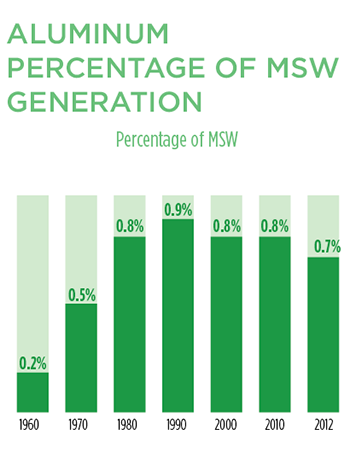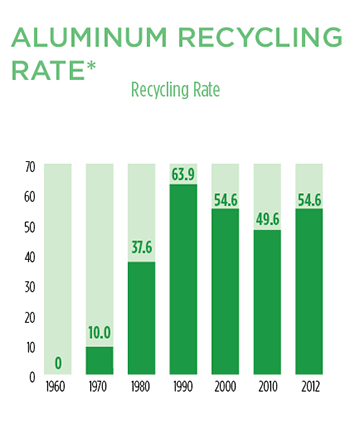Bauxite ore is refined into alumina (aluminum oxide), one of the primary feedstocks for aluminum metal. Scrap aluminum supplies 30 percent of America’s aluminum supply. Recycled aluminum cans supply a portion of the scrap used as a raw material.
About 26.5 percent of the aluminum used in America goes into packaging. This is the largest use for aluminum, ahead of transportation products, which use 23.7 percent. Aluminum is the second-most-used material in new automobiles worldwide.
Aluminum packaging is produced in both rigid and foil forms. Rigid aluminum containers are used for beverage and food packaging. Aluminum cans account for all of the beverage can market, but only a small percentage of the food can market. Cans are 76 percent of aluminum packaging by weight.
Foil packaging is used as a wrapping foil, as semi-rigid packages such as pie plates and frozen food trays, and as flexible packaging such as cigarette foil and candy wrappers.
Aluminum packaging has never had more than 1 percent market share of generated MSW.
Generated
1.87 million tons or 0.7% by weight.*
1.42 million tons of cans.*
450,000 tons of foil.*
11.9 pounds (lbs.) per person.*
9.03 lbs. of cans and 2.87 lbs. of foil per person.*
92 billion cans or 287 cans per person.
The average can weighs 0.463 oz.
 Recycled
Recycled

710,000 tons of cans or 54.6 percent.*
62 billion cans (or 67 percent of cans) in 2012 (industry data).
Foil is recycled, but EPA no longer tracks foil recycling.
Recycled Content
68 percent for cans in 2013 (industry data).
Composted
Aluminum packaging does not compost.
Burned or Landfilled
1.16 million tons or 0.7 percent of discarded MSW.*
710,000 tons of cans and 450,000 tons of foil.*
Aluminum is non-combustible and can create residue in incinerator ash.
Landfill Volume
6.5 million cubic yards or 1.6 percent of landfilled MSW in 1997.
5.3 million cubic yards of cans and 1.2 million cubic yards of foil in 1997.
Density
Landfilled cans weigh 250 lbs. per cubic yard (lbs./cu.yd.).*
Landfilled foil weighs 550 lbs./cu.yd.*
Loose cans have a density of 50-74 lbs./cu.yd.
Flattened cans have a density of 250 lbs./cu.yd.
Source Reduction
In 1972, 21.75 cans weighed 1 lb.
In 2012, 34.57 cans weighed 1 lb.
Markets
Aluminum can sheet manufacturers are the primary market for used aluminum cans. Foil is usually bought by the same markets.
 End Market Specifications
End Market Specifications

ISRI Guidelines for Nonferrous Scrap: NF-2014 includes “post-consumer aluminum can scrap” as well as “shredded,” “densified,” “baled” and “briquetted” aluminum used in beverage can scrap.
Contaminants include dirt, moisture, plastic, glass and other metals. Lead is a particular problem.
“Post-consumer aluminum foil” guidelines call for clean, dry foil.
Foil and cans use different alloys and will contaminate each other in the recycling process.
(* = 2012 U.S. EPA estimates)
Sources
Municipal Solid Waste Generation, Recycling, and Disposal in the United States: Facts and Figures for 2012, USEPA, Office of Solid Waste, 2013, epa.gov
Municipal Solid Waste Generation, Recycling and Disposal in the United States:
Facts and Figures for 1998, USEPA, Office of Solid Waste, 2000, epa.gov
Measurement Standards and Reporting Guidelines, National Recycling Coalition, Washington, D.C., nrcrecycles.org
Scrap Specifications Circular 2014, Institute of Scrap Recycling Industries, Washington, D.C., isri.org
About the Author
You May Also Like




.png?width=300&auto=webp&quality=80&disable=upscale)